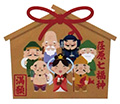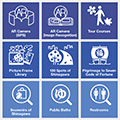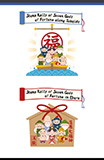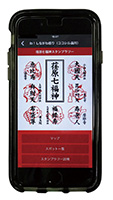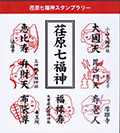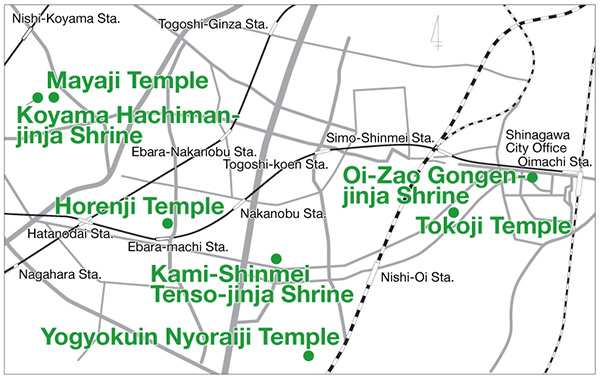Enjoy Shichifukujin Meguri with the Walking through Town App
Shichifukujin Meguri (Visit the Seven Deities of Good Fortune) with the Wa! Shinagawa Tourist Spots App
In Japan, there is custom called the “Shichifukujin Meguri,” in which people visit various temples and shrines at the beginning of the New Year to honor gods who bring seven types of happiness for that year. In the district, there are the Shichifukujin in the two districts of Former Tokaido and Ebara. You can see the people worship while walking during the New Year’s period.
The perfect app for such a walk is “Wa! Shinagawa Tourist Spots (Kokosil® Shinagawa).” You can use this app with a smartphone. The app introduces recommended spots in Shinagawa using AR (augmented reality) function in correspondence with multiple languages. Why not make a pilgrimage to see the Ebara Shichifukujin and pray for happiness for the New Year while discovering the attractive qualities of Shinagawa?
What is AR?
AR or augmented reality is a method that uses cameras, etc. to help you see images and information in a way that simulates the actual environment.
Languages: English, Chinese (traditional and simplified) and Korean
Note: The audio guide is also available in various languages.
Note: You have to pay the communication cost of downloading the app and receiving information.
Inquiries: Section Chief in charge of City Promotion, Public Relations Section
Tel: 03-5742-6043, Fax: 03-5742-6870
| Setup and Use of the App |
1. Install the Kokosil® app
Search for Kokosil® through the App Store for iOS devices or Google Play for Android devices and install it.
Note: Free of charge |
2. Start Kokosil® |
3. In “Kokosil selection” choose “わ!しながわTourist Spots [Kokosil® Shinagawa])” |
4. Select “Pilgrimage to Seven Gods of Fortune”
|
5. Select “Stamp Rally of Seven Gods of Fortune in Ebara/Tokai”
Note: We will introduce Ebara Shichifukujin in this issue.
* When you arrive at each spot, a stamp will automatically be downloaded to your smartphone. After you have visited all seven locations and collected all the stamps, you will receive an exclusive virtual photo frame. |
| Ways of Enjoying the App |
• Introduction of the “One Hundred Scenes of Shinagawa”
and original virtual photo frames
When you turn the app on and approach any of the “One Hundred Scenes of Shinagawa,” an explanation of the location and a function to speach text will appear on your screen. In addition, depending on the spot, an original virtual photo frame may appear, and you can take a commemorative photo with a mascot character.
• Tour courses with a lot of charm
There are various tour courses for places such as the 5 Mountains of Japan, waterway areas, cultural assets and cultural scenic spots, must-see locations for railway fans, museums and filming locations. You can also find shops with Shinagawa souvenirs, public baths and restrooms with this app.
• Stamp rallies with exclusive virtual photo frames
If you complete the “One Hundred Scenes of Shinagawa” tour or Tokai/Ebara Pilgrimage to Seven Gods of Fortune tour, you can receive an exclusive virtual photo frame for each. |
| Oi-Zao Gongen-jinja Shrine (1-14-8 Oi)—Fukurokuju |
Tokoji Temple (1-14-16 Futaba)—Bishamonten |
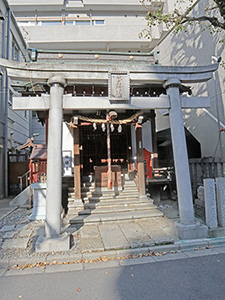 |
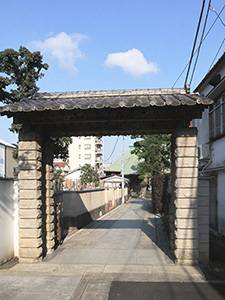
|
| According to legend, during the Edo Period when fires and epidemics were frequent this community was saved thanks to the “Tengu (long-nosed god)” of this shrine. There is a shrine for Fukurokuju at the left front of the shrine. |
This temple was established in 1534. Bishamonten can be found in the main hall in the temple grounds. Ususama Daimyouou is honored as the god of the toilet to prevent the disease of the lower. |
| Yogyokuin Nyoraiji Temple (5-22-25 Nishi-Oi)—Hoteison |
Kami-Shinmei Tenso-jinja Shrine (4-4-12 Futaba)—Benzaiten |
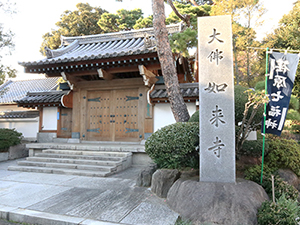
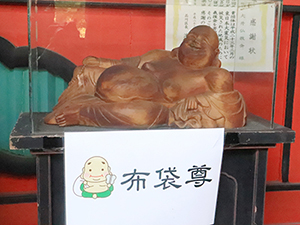
|
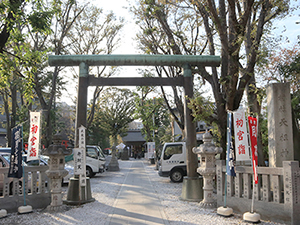
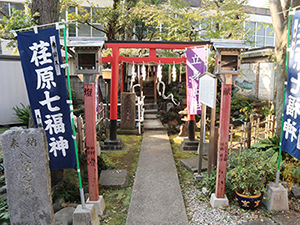 |
| There are 5 great Buddhas lined up side by side in Nyorai Temple, known as “the Great Buddhas of Oi.” The Statue of Hotei is stand in front of the great Buddhas. |
It is said that in 1322, during the drought of Musashi country (a part of the present Tokyo, Saitama, and Kanagawa), people prayed to Ryujin for rain, and this shrine was built for appreciation of escaped the crisis. If you proceed to the right side of the main hall, you will see Benzaiten enshrined. |
| Horenji Temple (3-6-18 Hatanodai)—Ebisu |
Mayaji Temple (7-6-9 Ebara)—Jurojin |
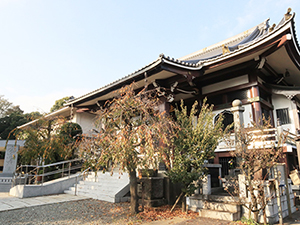 |
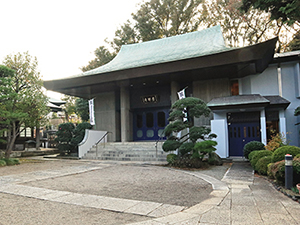
|
| This temple is related to Genji, who built the Kamakura shogunate (1185–1333), so the neighboring area of Nakanobu 5- and 6-chome is called “Genji-mae.” There is a small hall that enshrined Ebisu on the left side that entered the gate. |
Maya Hall is located on the left side of the main hall, and a standing statue of Madam Maya, the mother of the Buddha, is enshrined here. |
| Koyama Hachiman-jinja Shrine
(7-5-14 Ebara)—Daikokuten |


 |
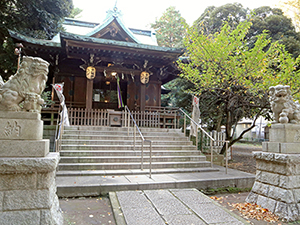 |
| Located on a hill which climbed the steep stone steps, this shrine has a wonderful view. In the back left side of the main hall is a hall for Daikokuten. |
| Shichifukujin (Seven Deities of Good Fortune) |
 |
Ebisu: Carrying a fishing pole and fish, Ebisu is believed to be the god of the fishing industry as well as the god of prosperous business. (Japan) |
 |
Daikokuten: Wearing a cowl on his head, carrying a small mallet in his right hand and a bag in his left, and Daikokuten is riding on a straw bag of rice. Daikokuten is believed to be the god of happiness, prosperity and good luck. (India) |
 |
Benzaiten: The only goddess of the seven lucky gods. Benzaiten is depicted as playing a biwa (harp). She is believed to be the goddess of multifaceted blessings, such as music, speech, intelligence, arts and sciences, and the accumulation of wealth. (India) |
 |
Bishamonten: Bishamonten is one of the Four Heavenly Kings in Buddhism, and is depicted wearing armor. Also known as Tamonten, he is believed to be a god who repels evil, attracts good luck and brings treasures. (India) |
 |
Jurojin: Jurojin is believed to be a god of longevity. He is depicted as an elderly man, carrying a staff. (China) |
 |
Fukurokuju: Fukurokuju is a god whose roots can be traced back to the Taoism of China. He is said to be the god of the three blessings of fuku (good luck), roku (wealth), and ju (longevity). Like Jurojin, he is depicted as an elderly man. (China) |
 |
Hoteison: Hoteison was a Buddhist monk said to be able to foresee a person’s good and bad luck as well as the weather. Depicted carrying a big cloth bag, he was nicknamed Hotei (cloth bag), and is believed to be the god of prosperity. (China) |
 |
|


